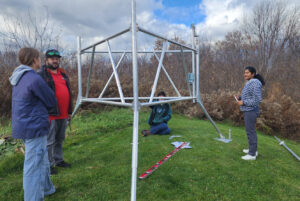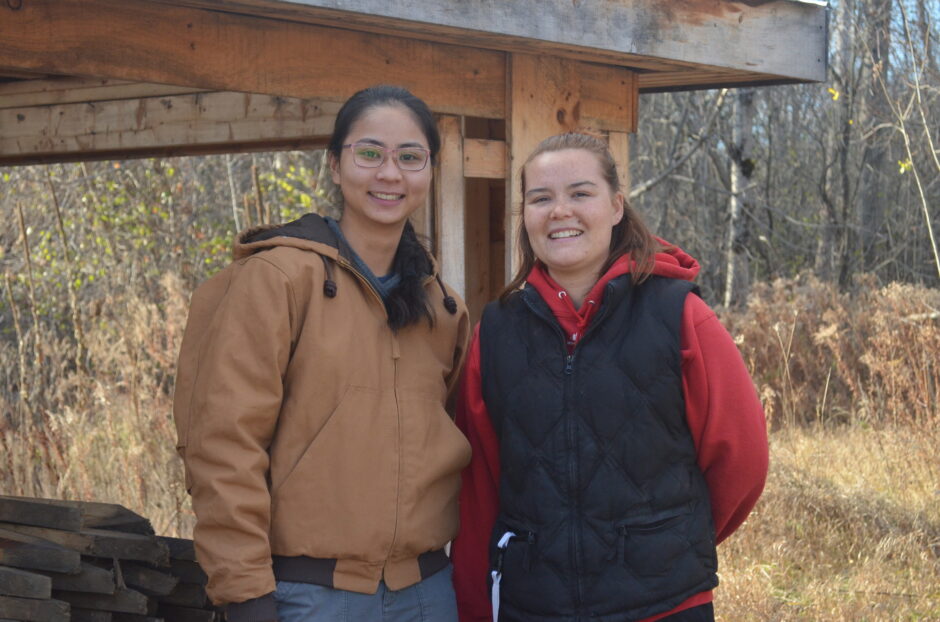Environmental tech students build weather station after years of anticipation

Algonquin College’s Pembroke campus has been dreaming of building a weather station for years. Now, despite certain challenges, the environmental technician program has been able to realize that dream and launch their very own weather station.
After years of inaction due to working out logistical issues such as who would build the weather station and where on campus it should go, the environmental technician program took it on.
As part of a Level 3 course based on land and water stewardship, students are assigned to work on a project that focuses on bettering the college community and collecting environmental data within the region. One of these projects turned into the weather station.
Four students were initially assigned to build and run the station, but one dropped out of the program leaving the project in the hands of three students — Jenna Drefke, Pragnya Singidi and Juniper Galt.
At the start of the fall semester, when the weather station team began their planning, they outlined why their project was important — the weather station will help educate future environmental technician students, high school students and authorities within the region, with the aim of spreading awareness for climate change and keep Pembroke informed on the weather.
“It’s (the weather station) really important for climate change because it covers all the parameters that affect climate change,” said Drefke.
Their mission this semester is to collect as much data as they can. Data is collected through numerous sensors which gathers information on precipitation levels, solar radiation, temperature, humidity and wind patterns. After the data is collected, it is sent to a computer through an EON2 GOES/Meteosat antenna.
“We are working on it to collect data and use it for future students,” said Singidi. “For instance, for measuring the precipitation, we’ll get to know how much rain we had in past weeks.”

A survey done by Abacus Data found 63 per cent of Canadians are concerned about climate change. Weather stations have always been an important way to track how climate is changing and inform the public of the same.
According to Environmental XPRT, weather stations are significant because of the information they provide. Meteorologists use weather stations to help predict weather trends and forecast natural disasters, as well as study climate trends. Farmers use weather stations to make decisions about their crops.
Not only is the weather station helpful for the public, but it is also helpful for the students in the environmental technician program. All the projects in the land and water stewardship course are designed to give students hands-on learning. Since the weather station team was building the station from the ground up, they faced several challenges over the semester.
One challenge the team faced was programming the equipment for the weather station. The team said their programming “involved a lot of trial and error,” resulting in the team wondering if the station could even be installed by the end of the year. However, to ensure success, the team decided to focus only on the weather-specific equipment – scrapping the original plan to install soil and water monitoring as well as the weather monitoring.
Despite these challenges, the team was able to come out on top, with the weather station becoming functional on Nov. 8. The team said the experience was great and really helped their learning.
“We didn’t have experience (using) mechanical tools and fixing these things,” said Singidi. “We don’t know the actual tools, how it works, how they (the weather station equipment) collect data.”
But now, Singidi and her team do know. And, with the stress of building the weather station out of the way, the team is able to learn from their creation.
“It’s certainly an achievement,” said Galt. “It was one that came with a lot of stress and frustration. I’m mostly just glad it’s done.”
This “achievement,” Galt said, is one that has “immense potential as a classroom resource.”
Singidi agrees with this sentiment and said the weather station provides useful information for students’ learning.
“Climate change means a sudden wind change, sudden rain, or like the wind direction or radiation change,” said Singidi. “That’s what we can measure. And by collecting the data from months, we can estimate what is going to happen next year or month.”
This is just the beginning for the weather station. Plans for next year include adding the soil and water monitoring sensors that were scrapped this year. As the years go by and the station collects more data, students will be able to analyze any trends found in the data. Galt said the data the station collects could also lead to future projects for the environmental technician students.
As the weather station team finish their final semester of the environmental technician program, they reflected on what led them to the program in the first place.
Galt said she has always loved the outdoors and grew up reading non-fiction novels about nature. This love for nature is what led her to the program as she wanted to help the environment.
“There’s something about it that feels like a duty, but I also enjoy learning about the subject matter,” said Galt.
Drefke feels the same as Galt.
“I have a strong passion for protecting the environment and there are a lot of environmental issues locally around the world,” said Drefke. “To be able to help fix those issues, I believe a better understanding of the environment itself would be the first step. This program provides that information.”
Singidi has a biotechnology degree, but knew she wanted to do more hands-on work. The environmental technician program and her experience working on the weather station has given her the experience she wanted.
“It’s about using my background in science to contribute to meaningful change and to help create a healthier, more sustainable world,” said Singidi. “We hope this project will benefit students and professors.”








